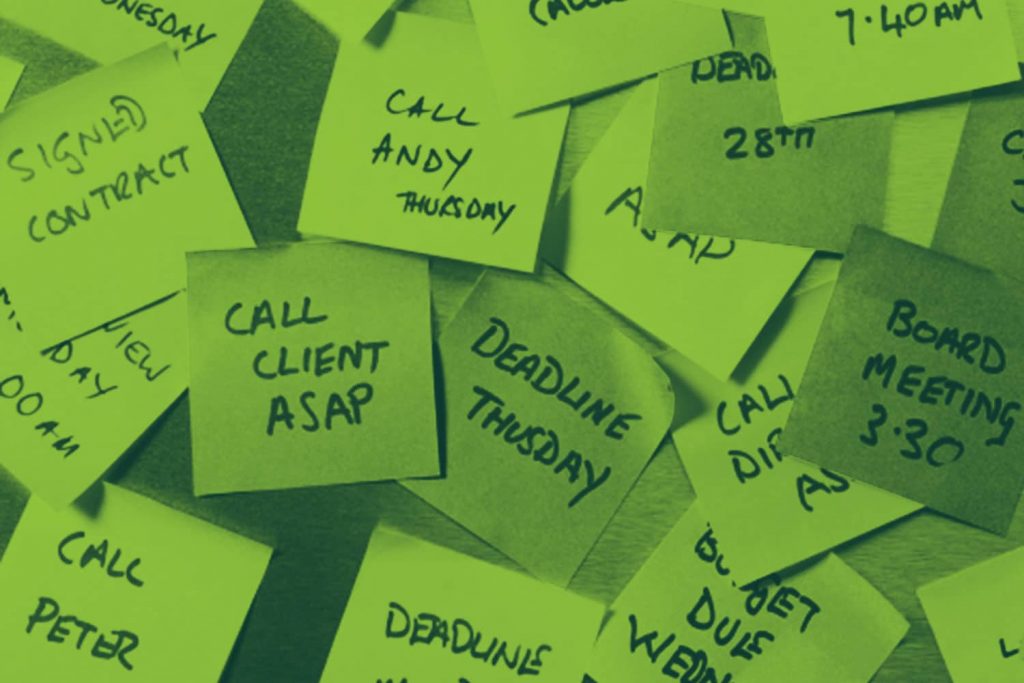8. It’s OK to say, “I’ll deal with that later.”
As a part of the “mental sweep,” there’s a time when one is collecting everything in an inbox for later processing. During this step it’s easy to get distracted as soon as a new object comes into your field of view, but it’s important to put that item in the box and keep collecting.
If you have a good system established for after your “mental sweep” is complete (e.g.: “GTD”/Getting Things Done), you’ll have the tools in place to give proper attention to that item and not get distracted in the meantime.
9. You don’t have to reinvent the wheel.
One of the mistakes I’ve made in this area over the years is always trying to create a perfect system to fit my exact needs. As a “recovering perfectionist,” it’s sort of par for the course. That said, there are no perfect systems – so the first step in adopting a good system is to recognize that you don’t have to reinvent the wheel.
Consider embracing a system that is already established. “Getting Things Done” by David Allen, and “The Action Method” (from “Making Ideas Happen”) by Scott Belsky, are both great ones. If you try to create your own, you may end up somewhere in the weeds with nothing accomplished and more anxiety than you know what to do with.
10. Everything can (and should) fit into one box.
Rather than separating your “work” tasks from your “personal” tasks — and so on — consider pulling everything into one single system. The temptation is often to keep these areas separate, but that can often lead to a split focus and some sets of tasks not getting the attention (action) they deserve.
Consider contexts for your tasks. Maintain active lists for actions to take / things to do when you are near a phone (calls), sitting in front of a computer (computer), at home (home), running errands (get), and so on. Everyone has a series of unique contexts based on their own personal set of responsibilities, so craft yours accordingly.
While introducing productivity software is not the focus of this post, there are some good ones (and some bad ones) out there. I like Things ($49.95 from Cutured Code, Mac only) and OmniFocus ($79.99 from The Omni Group, Mac only.)
Both of these are great and contain iPhone and iPad versions that automatically sync with each other. I think overall, Things is a little easier to use for the beginner while OmniFocus is better left to the GTD power-user. That said, one can accomplish the exact same thing with a series of lists in Reminders on the Mac, or Tasks in Outlook on the PC. Software is just a tool.
Don’t get hung up on having or using software. The best approach is to sometimes to start without a specific software application and master the approach using old school pen and paper. Then, if you still want a digital system, you’ll really know what your needs truly are.
11. It’s probably easier than we’re making it.
We can make the process much harder than it needs to be. In a world where the self-improvement niche has been the most profitable in the publishing industry for the last two decades, there is enormous pressure for authors and gurus to create complex, multi-faceted systems that over complicate what should be incredibly simple.
There is likely a reason you and I struggle with these things and why its so hard to find an easy answer. For the most part, the recipe for success is a good portion of common sense mixed with a true understanding of what’s most important to you, and a dash of personal responsibility.
12. Sometimes it’s easier (and OK) to scrap everything and start fresh.
There are times when it’s not worth trying to fix a productivity system that’s broken. Sometimes a fresh start with an established system can be the ingredient we’ve been missing.
Take a look back on your challenges in this area.If you are struggling with more “process-related” challenges than the tasks themselves, giving something new a try might be a good exercise.
13. The long-term is more important than the short-term (despite what your anxiety-filled sweat glands tell you).

Paradoxically, it’s usually the “important, but not urgent” items that get the least amount of attention. If we want to have success–whatever you define that to be in your life–we have to focus on the things that will propel us forward, and that’s almost always the stuff of Quadrant 2.
While it may make us feel good to accomplish something when we are overwhelmed, just checking things off the list is not the answer.
14. Commit to the system.
Whatever system you use, it will only work if you are consistent with it. Establishing habits that align with your goals and objectives will greatly increase your chances of success.
I recently read “The Power of Habit: Why We Do What We Do, and How to Change” by Charles Duhigg. It’s a fantastic resource that I would highly recommend to anyone that’s interested in understanding how to establish new habits for success, and how to correct–or change–habits that already exist.
15. Apply it to every area of your life.
Success, whatever you define it to be, only happens when we apply these principles to every area of our lives. For many of us, we’ve been living a mis-aligned life for far too long because we have failed to apply teachings and principles that work for every aspect of our life.
If you’re not flourishing around your productivity and habits, consider these observations and how their implementation might help align your efforts.
Question: How are you managing your productivity efforts? I’d love to hear what you are doing…



